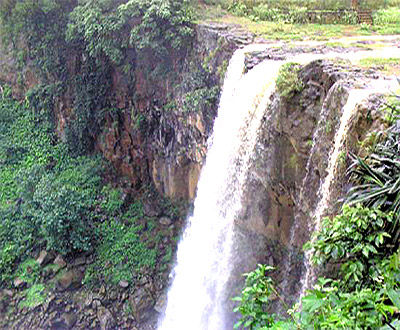 Amarkantak is a pilgrim town and a Nagar Panchayat in Anuppur District in the Indian state of Madhya Pradesh. With the Maikal Hills being the fulcrum the city is majestically located in the midst of magnificent Vindhya Mountain Range and Satpura Mountain Range at an elevation of 1065 meters. Amarkantak is situated at 22.67degreeN 81.75degreeEast.
Amarkantak is a pilgrim town and a Nagar Panchayat in Anuppur District in the Indian state of Madhya Pradesh. With the Maikal Hills being the fulcrum the city is majestically located in the midst of magnificent Vindhya Mountain Range and Satpura Mountain Range at an elevation of 1065 meters. Amarkantak is situated at 22.67degreeN 81.75degreeEast.
Amarkantak is known primarily as a religious place. The holy rivers like Narmada River, Sone River and Johila River emerge from here. The city is also called `Teerthraj` meaning the king of pilgrimages. The holy town of Amarkantak attracts thousands of sages and devotees all through the year. Therefore numerous ashrams or religious retreats have been established around this place.
History of Amarkantak
Amarkantak is a Sanskrit word with much mythological significance, which gains it the prestigious sobriquet as Theertharaja. Holiness of Amarkantak is greatly associated with the holy river Narmada. Perhaps it is due to the presence of this holy river that this locale in the Vindhyans gets much popularity as a devout centre. As per the Holy Scriptures, River Narmada transcends all other sacred rivers with her indomitable virtue as the daughter of Lord Shiva. Legends has it that a mere glance of this beloved daughter of the destroyer God would fetch innumerable boons and the devotees strongly believe that who ever dies at Amarkantak would fetch salvation.
A land with a vivid history, Amarkantak narrates the tales of various dynasties, right from the Pandavas to the foreign rule of the modern times. Due to occupation of this area by Mandhata the descendants of Yayati moved from this area to west of Madhya Pradesh and settled on the banks of Narmada River. According to tradition, this Vindhyachal area was included in the Kingdom of Ayodhya, Kapila Muni, Bhrigu Rishi and Markandeya Rishi had ashrams here. It is also said that Pandavas stayed here and gained spiritual benefits during their exile. Each edifice in Amarkantak portrays diverse styles that recount the period during which these architectural grandeurs were materialized. This stunning facade of Amarkantak gently adds the magnificence of this legendary spot to a great extent.
Flora and Fauna of Amarkantak
The temperate climate and the equitable distribution of rain make Amarkantak an ideal plateau for dense vegetation cover. The forests have sal dominated and are home to other associate species such as Mallotus Philipensis, Buchanania lanzan, Ougeinia oojeinesis, Terminalia chebula, Bauhinia spp, Grewia spp, Gardenia latifolia, Anogeissus latifolia and other climbers and shrubs. Down below the valleys there are mixed forests, which include Bauhinia retusa, Grewia spp. Bursera serrata Rhamnus wightii, Schleichera oleosa, Schefflera venulosa and many others. There are even plants of the north-west and central Himalayas to be found in Amarkantak.
Tourist Places in Amarkantak
There are many tourist places in Amarkantak. Few of them are mentioned below:
Kapildhara
 Kapildhara waterfall is located at six km northwest of Narmadakund. It is with a fall of about hundred feet. According to history Kapila Muni resided here. Kapil Muni performed severe austerities here and also received divine light. He even wrote `samkhya philosophy` at this place. The Kapileshwar temple is also located in the vicinity.
Kapildhara waterfall is located at six km northwest of Narmadakund. It is with a fall of about hundred feet. According to history Kapila Muni resided here. Kapil Muni performed severe austerities here and also received divine light. He even wrote `samkhya philosophy` at this place. The Kapileshwar temple is also located in the vicinity.
Narmadakund and Temples
At the place of origin of Narmada River there is an open pool known as Narmadakund. There are number of temples around this kund such as Narmada and Shiva temple, Kartikey temple, Shri Ram Janki temple, Annapurna temple, Guru Gorakhnath temple, Sri Shuryanarayan temple, Vangeshwar Mahadev temple, Durga temple, Shiv Pariwar, Siddheswar Mahadev temple, Sri Radha Krishna temple, Eleven Rudra temple and others.
Sonemuda
Sonemuda is a source of Sone River. This holy place is situated at a distance of 1.5 km from Narmadakund at the very edge of Maikal Mountain. The Sone River flows from the mountain in a waterfall that is hundreds of feet long. The waterfall is surrounded by thick forests and valleys. According to Megasthanes and other Aryan writers the river Sone got its name from gold as gold dust is found in the water of Sone.
Mai ki Bagiya
Mai ki Bagiya is one of the prettiest locations in Amarkantak that have been setup in honour of the goddess Narmada. Legend has it that mother Narmada used to pluck flowers from this garden. In this natural garden there are Mango, Banana and other fruit trees along with Gulbakavli, roses and other flower plants.






